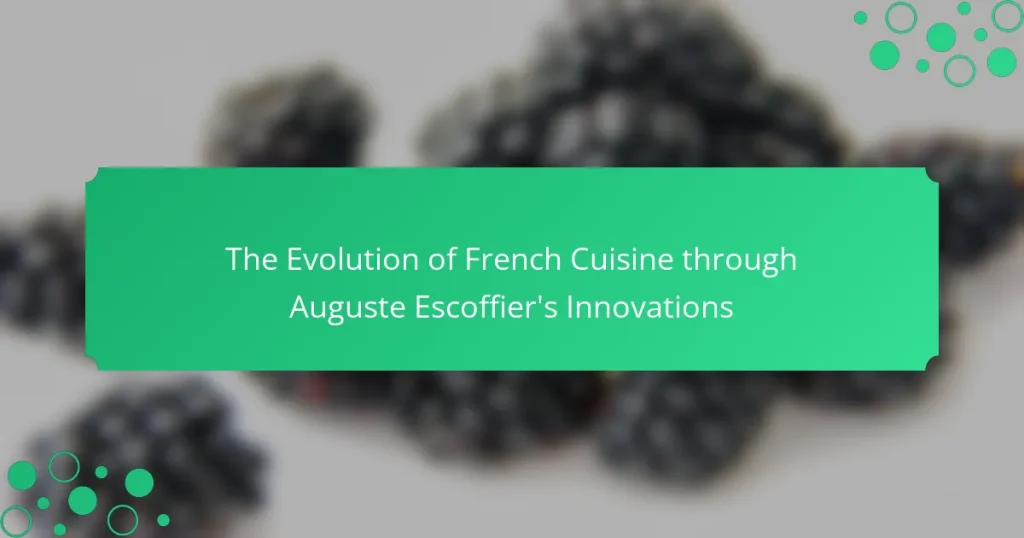Auguste Escoffier is a pivotal figure in the evolution of French cuisine, recognized for his transformative innovations in culinary techniques and kitchen organization. He standardized recipes and introduced the brigade system, which streamlined kitchen operations and enhanced meal preparation efficiency. Escoffier’s publication of “Le Guide Culinaire” laid the groundwork for culinary education and established foundational concepts such as “mother sauces.” His emphasis on fresh ingredients and seasonal menus reflects a significant cultural shift in France, promoting professionalism and accessibility in gourmet cooking. Today, modern chefs continue to apply Escoffier’s principles, focusing on organization, classic techniques, and the quality of ingredients to create exceptional dining experiences.

What is the significance of Auguste Escoffier in French cuisine?
Auguste Escoffier is significant in French cuisine for revolutionizing culinary techniques and organization. He is known as the “father of modern cuisine.” Escoffier standardized recipes and kitchen practices. He introduced the brigade system, which organized kitchen staff into specific roles. This system improved efficiency and consistency in meal preparation. He also published “Le Guide Culinaire,” a foundational cookbook in culinary education. His influence extended globally, shaping culinary practices beyond France. Escoffier’s work elevated cooking to an art form, emphasizing quality and presentation. His legacy continues to impact chefs and culinary professionals today.
How did Escoffier’s innovations change traditional French cooking?
Escoffier’s innovations significantly redefined traditional French cooking. He introduced the brigade system, which organized kitchen staff into specific roles. This improved efficiency and consistency in food preparation. Escoffier also emphasized the importance of fresh ingredients and seasonal produce. He refined classic recipes, simplifying them while enhancing their flavors. His approach to sauces, particularly the five mother sauces, standardized French cuisine. Escoffier published “Le Guide Culinaire,” which became a foundational text for chefs. His methods influenced culinary education and restaurant practices worldwide. These changes established modern French cuisine as a respected culinary art.
What specific techniques did Escoffier introduce to French cuisine?
Auguste Escoffier introduced several specific techniques to French cuisine. He popularized the use of the brigade de cuisine system. This system organized the kitchen staff into specific roles for efficiency. Escoffier also emphasized the importance of fresh ingredients. He developed techniques for precise cooking times and temperatures. Additionally, he refined the art of sauce making. His techniques included the preparation of mother sauces. Escoffier’s approach to presentation elevated the visual appeal of dishes. His innovations laid the foundation for modern French culinary practices.
How did Escoffier’s approach to ingredients influence culinary practices?
Escoffier’s approach to ingredients revolutionized culinary practices by emphasizing quality and simplicity. He advocated for the use of fresh, seasonal ingredients. This focus ensured that flavors were enhanced rather than masked by heavy sauces. Escoffier also introduced the concept of mise en place, which organized ingredient preparation. This method streamlined cooking processes and improved efficiency in the kitchen. His techniques promoted the idea of respecting the natural taste of each ingredient. This philosophy influenced chefs globally, leading to a shift towards lighter and more refined dishes. Escoffier’s practices remain foundational in modern culinary arts.
Why is Escoffier considered the father of modern cuisine?
Auguste Escoffier is considered the father of modern cuisine due to his revolutionary approach to cooking and culinary organization. He introduced the concept of the kitchen brigade, streamlining kitchen operations. This system improved efficiency and professionalism in culinary arts. Escoffier also emphasized the importance of fresh ingredients and seasonal cooking. He published “Le Guide Culinaire,” which standardized recipes and techniques. His work laid the foundation for contemporary French cuisine. Escoffier’s influence is evident in modern culinary education and restaurant practices. His legacy continues to shape the culinary world today.
What philosophies did Escoffier advocate regarding kitchen organization?
Escoffier advocated for a structured and hierarchical kitchen organization. He introduced the brigade system, which divided kitchen tasks among specialized roles. This system improved efficiency and streamlined operations in the kitchen. Each chef had specific responsibilities, enhancing accountability. Escoffier emphasized the importance of mise en place, ensuring that all ingredients were prepped before cooking. He believed that organization reduced chaos and improved the quality of dishes. His philosophies transformed professional kitchens and remain influential today.
How did Escoffier’s methods improve efficiency in professional kitchens?
Escoffier’s methods improved efficiency in professional kitchens through the introduction of the brigade system. This system organized kitchen staff into specific roles, streamlining workflow. Each member had defined responsibilities, reducing confusion and overlap. Escoffier also emphasized mise en place, ensuring all ingredients were prepped before cooking. This practice minimized delays during service. Additionally, he standardized recipes, which facilitated consistent food quality and faster preparation times. His techniques allowed kitchens to serve more guests in less time, enhancing overall productivity.

What were the key innovations introduced by Escoffier?
Auguste Escoffier introduced several key innovations to French cuisine. He is known for modernizing the classical French cooking techniques. Escoffier developed the brigade de cuisine system, which organized kitchen staff into specific roles. This system improved efficiency in restaurant kitchens. He also emphasized the importance of fresh ingredients and seasonal menus. Escoffier created the concept of “mother sauces,” foundational sauces from which many others are derived. He popularized the use of precise cooking times and temperatures. His approach to menu planning included the careful pairing of dishes for balance and harmony. These innovations significantly shaped modern culinary practices and restaurant operations.
How did Escoffier redefine the concept of culinary service?
Auguste Escoffier redefined culinary service by introducing a systematic approach to kitchen organization. He established the brigade system, which organized kitchen staff into specific roles. This structure improved efficiency and communication during meal preparation. Escoffier also emphasized the importance of presentation and service quality. He believed that dining should be a complete experience, not just about the food. His innovations included the use of à la carte menus, which allowed diners to choose individual dishes. Escoffier’s focus on professionalism elevated the standards of culinary service. His methods are still foundational in modern kitchens today.
What role did the brigade system play in Escoffier’s kitchen innovations?
The brigade system was crucial to Escoffier’s kitchen innovations. It organized kitchen staff into specific roles and responsibilities. This structure improved efficiency and communication in the kitchen. Each station focused on a particular task, such as sauces or vegetables. This specialization allowed for faster meal preparation. Escoffier implemented this system in high-end restaurants, enhancing service quality. It also reduced kitchen chaos during busy service times. The brigade system remains a foundational concept in modern culinary operations.
How did Escoffier’s menu planning change the dining experience?
Escoffier’s menu planning revolutionized the dining experience by introducing a structured approach to cuisine. He organized meals into distinct courses, enhancing the flow and timing of dining. This method allowed for a more refined and elegant presentation of dishes. Escoffier also emphasized seasonal ingredients, which improved the quality and freshness of meals. His use of a la carte menus gave diners more choices and control over their dining experience. Additionally, he standardized recipes, ensuring consistency and quality across different establishments. These innovations transformed dining into a more sophisticated and enjoyable event, setting new standards in culinary practices.
What are the lasting impacts of Escoffier’s recipes and techniques?
Escoffier’s recipes and techniques have profoundly influenced modern culinary practices. His emphasis on organization and efficiency in the kitchen transformed professional cooking. The brigade system he developed streamlined kitchen operations, enhancing productivity. Escoffier also popularized the use of fresh ingredients and seasonal flavors. His classic recipes, such as sauces and stocks, remain foundational in French cuisine. The principles he established, including mise en place, are now standard in culinary training. Escoffier’s work laid the groundwork for contemporary haute cuisine. His legacy continues to inspire chefs worldwide, shaping culinary arts today.
Which classic dishes are attributed to Escoffier’s influence?
Auguste Escoffier is credited with classic dishes such as Bouillabaisse, Chateaubriand, and Tournedos Rossini. He refined French cuisine and established modern culinary techniques. His contributions include the creation of sauces like Sauce Espagnole and Sauce Hollandaise. Escoffier also popularized dishes such as Peach Melba and Pêche Melba. His influence is evident in the organization of kitchen brigades and the emphasis on fresh ingredients. These innovations have shaped contemporary cooking practices globally.
How do modern chefs incorporate Escoffier’s principles into their cooking?
Modern chefs incorporate Escoffier’s principles by emphasizing organization, technique, and flavor balance in their cooking. They adopt the brigade system, which streamlines kitchen operations and enhances efficiency. This system assigns specific roles to each team member, ensuring a structured workflow. Chefs also utilize classical techniques such as sautéing and braising, which Escoffier refined. These methods enhance the depth of flavor in dishes. Additionally, modern chefs focus on high-quality ingredients, reflecting Escoffier’s belief in using the best available produce. They often present dishes with elegance, mirroring Escoffier’s emphasis on visual appeal. Finally, many chefs incorporate seasonal menus, honoring Escoffier’s commitment to freshness and sustainability in cuisine.

In what ways did Escoffier’s work reflect cultural changes in France?
Escoffier’s work reflected cultural changes in France by modernizing French cuisine and emphasizing professionalism. He introduced the brigade system, which organized kitchen staff and improved efficiency. This change mirrored the industrialization of France, promoting a more structured approach to work. Escoffier’s focus on seasonal ingredients highlighted a growing appreciation for local produce. Additionally, his simplified recipes made gourmet cooking more accessible, aligning with the democratization of food culture. His publication, “Le Guide Culinaire,” standardized French culinary techniques, influencing both chefs and home cooks. Overall, Escoffier’s innovations represented a shift towards modernity and professionalism in French gastronomy.
How did historical events shape Escoffier’s culinary innovations?
Historical events significantly influenced Escoffier’s culinary innovations. The Franco-Prussian War of 1870-71 led to a national focus on French identity, which Escoffier embraced through refined cuisine. The industrial revolution introduced new techniques and ingredients, allowing Escoffier to modernize cooking methods. His experiences in the military also instilled discipline and organization in kitchen operations. The rise of tourism in France increased demand for high-quality dining experiences, prompting Escoffier to innovate menus. The establishment of culinary schools provided a platform for his teachings and techniques. Escoffier’s work during the Belle Époque era showcased a blend of tradition and modernity, solidifying his impact on French cuisine.
What cultural influences can be seen in Escoffier’s recipes?
Escoffier’s recipes reflect significant cultural influences from French, Italian, and classical cuisine. French culinary traditions are evident in his emphasis on technique and presentation. Italian influences appear in his use of fresh ingredients and simplicity in flavor. Classical cuisine is showcased through Escoffier’s incorporation of sauces and stocks, which are foundational to French cooking. His recipes also highlight the importance of seasonal ingredients, aligning with broader European culinary practices. The blending of these influences helped shape modern French gastronomy.
How did Escoffier’s work contribute to the globalization of French cuisine?
Escoffier’s work significantly contributed to the globalization of French cuisine through standardization and modernization. He redefined classical French cooking techniques and created a structured kitchen brigade system. This system improved efficiency and consistency in food preparation. Escoffier also published influential cookbooks, such as “Le Guide Culinaire,” which disseminated French culinary practices worldwide. His emphasis on quality ingredients and presentation elevated French cuisine’s status. Escoffier’s work in luxury hotels and restaurants introduced French cuisine to international audiences. He played a key role in establishing French culinary schools, further spreading the cuisine’s influence. His legacy laid the groundwork for French cuisine’s global recognition and adaptation.
What challenges did Escoffier face in his culinary career?
Auguste Escoffier faced several challenges in his culinary career. He encountered fierce competition within the culinary field. Many chefs sought to establish their own reputations and innovations. Escoffier also dealt with the evolving tastes and expectations of customers. The shift towards more refined dining experiences required constant adaptation. Additionally, he faced the pressures of managing large kitchen brigades. This demanded strong leadership and organizational skills. His military service during the Franco-Prussian War interrupted his career. This period affected his early professional development. Despite these challenges, Escoffier’s resilience and creativity led to significant contributions to French cuisine.
How did Escoffier overcome resistance to his innovative ideas?
Auguste Escoffier overcame resistance to his innovative ideas by demonstrating their effectiveness through practical application. He implemented a clear organizational structure in kitchens, known as the brigade system. This system improved efficiency and streamlined operations. Escoffier also emphasized the importance of quality ingredients and precise techniques. He published influential cookbooks, such as “Le Guide Culinaire,” which showcased his methods. These publications helped educate chefs and legitimized his approaches. Escoffier’s success in high-profile restaurants further validated his innovations. His ability to adapt and refine traditional French cuisine gained acceptance among peers and critics alike.
What personal experiences influenced Escoffier’s culinary journey?
Auguste Escoffier’s culinary journey was influenced by his early experiences in the kitchen. He began his apprenticeship at a restaurant in his hometown at the age of 13. This formative experience exposed him to professional cooking techniques. He later worked in prestigious establishments in Paris, including the famed restaurant Le Petit Moulin Rouge.
His time in the French army during the Franco-Prussian War also shaped his culinary skills. He learned to cook for large groups, which enhanced his efficiency and organization in the kitchen. Escoffier’s travels to various countries introduced him to diverse cuisines and cooking methods.
These experiences contributed to his innovative approach to French cuisine. They helped him develop the principles of modern culinary techniques and the brigade system. His personal journey laid the foundation for his later contributions to gastronomy.

How can modern chefs apply Escoffier’s principles today?
Modern chefs can apply Escoffier’s principles today by emphasizing organization and mise en place. Escoffier’s method of preparing ingredients in advance enhances efficiency in the kitchen. He promoted the brigade system, which modern chefs still use to assign specific roles. This structure improves workflow and communication among kitchen staff.
Additionally, Escoffier’s focus on classic techniques remains relevant. Techniques like sautéing, poaching, and braising are foundational in culinary education. Modern chefs incorporate these methods while adapting them to contemporary ingredients and tastes.
Escoffier also valued simplicity and quality of ingredients. This principle encourages chefs to source fresh, local produce for their dishes. By prioritizing flavor and presentation, chefs create memorable dining experiences.
Lastly, Escoffier’s dedication to culinary arts as a profession inspires modern chefs to pursue excellence. His influence fosters a culture of respect and creativity in the kitchen today.
What best practices can chefs adopt from Escoffier’s techniques?
Chefs can adopt several best practices from Escoffier’s techniques. First, they should emphasize the importance of mise en place. This practice involves preparing and organizing all ingredients before cooking. It enhances efficiency and ensures a smoother cooking process. Second, chefs should focus on the classical French cooking methods. Techniques like sautéing, poaching, and braising form the foundation of many dishes. Mastering these methods elevates culinary skills.
Third, Escoffier advocated for a clear kitchen hierarchy. Establishing roles within the kitchen improves workflow and accountability. Fourth, chefs should prioritize the quality of ingredients. Escoffier believed in using fresh, seasonal produce for the best flavors. This principle remains crucial in modern cuisine.
Additionally, chefs can adopt Escoffier’s focus on presentation. He emphasized the visual appeal of dishes. Finally, continuous learning and adaptation are essential. Escoffier’s techniques encourage chefs to innovate while respecting tradition. These practices contribute to a well-rounded culinary approach.
How can understanding Escoffier’s methods enhance a chef’s skill set?
Understanding Escoffier’s methods can significantly enhance a chef’s skill set. His techniques emphasize precision and organization in the kitchen. Mastering Escoffier’s brigade system improves kitchen efficiency. This system assigns specific roles to kitchen staff, streamlining operations. Learning his classic cooking techniques provides a strong foundation in culinary arts. These techniques include sauce preparation and proper ingredient handling. Escoffier also introduced the concept of mise en place, promoting better workflow. By adopting these practices, chefs can elevate their culinary creations. His influence on modern cuisine is profound, shaping professional cooking standards today.
What resources are available for chefs to learn about Escoffier’s contributions?
Chefs can learn about Escoffier’s contributions through various resources. Key resources include his seminal book, “Le Guide Culinaire,” which outlines his culinary techniques and principles. Culinary schools often include Escoffier’s work in their curriculum. Online courses and webinars focus on classic French cooking techniques inspired by Escoffier. Documentaries and cooking shows often highlight his impact on modern cuisine. Additionally, numerous articles and journals discuss his innovations and their relevance today. Cookbooks by contemporary chefs often reference Escoffier’s methods. These resources collectively provide a comprehensive understanding of his contributions to French cuisine.
The main entity of the article is Auguste Escoffier, a pivotal figure in the evolution of French cuisine. The article outlines Escoffier’s significant contributions, including the introduction of the brigade system, standardization of recipes, and emphasis on fresh ingredients, which collectively revolutionized culinary practices. It discusses specific techniques he introduced, such as the preparation of mother sauces and the concept of mise en place, which enhanced efficiency in professional kitchens. Additionally, the article examines how Escoffier’s innovations reflected cultural changes in France and contributed to the globalization of French cuisine, as well as the lasting impacts of his work on modern culinary arts.




